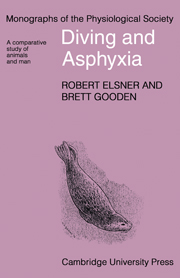6 - Perinatal asphyxia and survival
Published online by Cambridge University Press: 18 May 2010
Summary
The problem of science will consist precisely in this, to seek the unitary character of physiological and pathological phenomena in the midst of the infinite variety of their particular manifestations
(Claude Bernard, 1865).The process of birth, involving the transition from placental to lung respiration, exposes the mammalian infant to asphyxial threats. Signs of its presence are revealed by measurement of blood gases and pH in samples of blood obtained during birth and in the observation of a transient or persisting decline in heart rate. It is not surprising therefore that the terrestrial animal fetus and neonate are more tolerant of asphyxia than are adults of the same species. The interesting history of knowledge concerning this advantage dates from experiments on kittens by Robert Boyle in the seventeenth century (Dawes, 1968). Adaptations leading to oxygen sparing, an increased dependence upon anaerobic metabolic processes and an augmented capacity for tissue buffering of the accumulated end-products have been identified. The major requirement during oxygen deprivation, as with diving animals, is for protection of the integrity of the least resistant vital organs, the brain and heart. Some adaptive mechanisms appear common to both perinatal animals and diving species. There are, however, some important differences.
Fetal and neonatal resistance to asphyxia
While mammalian species vary greatly in their resistance to asphyxia at birth, the general rule of superiority over adults of the same species holds true. However, new-born seals, and probably new-born marine mammals generally, tolerate asphyxia less well than do adult animals.
- Type
- Chapter
- Information
- Diving and AsphyxiaA Comparative Study of Animals and Man, pp. 104 - 114Publisher: Cambridge University PressPrint publication year: 1983



